Model for Semi-Automatic Serious Games Generation
Abstract
1. Introduction
2. Related Work
2.1. Models for Developing Serious Games
2.2. Tools for Developing Serious Games
3. Model Proposal
3.1. Phase A: Serious Game Configuration
- Enter the name of the video game that will appear as the title of the SG.
- Select the main character. You will be able to choose between three different characters that can be the main character of the story. There are three main characters available: Ximena, Ruben and Nino.
- Select the story. The user will be able to select among the three different stories available for the SG:
- A quest storyline.
- A rescue storyline.
- An invasion storyline.
- Select the number of levels. The user must select how many levels the student will be able to interact with, one level as the minimum and five as the maximum. The user must consider that at least each level must have three questions that in the next module must be attached to each of the selected levels.
- In the next step, the five available scenarios for the game are presented. One scenario must be associated with a game level:
- Forest.
- Desert.
- Snowy mountain.
- Cemetery.
- Pantheon.
- Validate that each level that the video game wants has a scenario assigned to it.
- Confirm if the user wants this configuration. If it is true, it advances to step number 8; if it is false, it goes back to the configuration from step number 1.
- An XML file is created with the tags that will be used for the generation of the code and the information of the preferences selected by the user for the serious video game he/she wants is saved.
- The validation that the XML file was created and that the corresponding information was saved is made.
- A validation of the XML file is performed, which determines if there are any errors in the XML file. If everything is saved, it will go to step number 12; otherwise, it will go to step number 11.
- An error message is presented to inform the user what went wrong.
3.2. Phase B Content Configuration
- 12.
- The option to upload the questions from a CSV file is offered. If you accept this option, you will move to step 13. If you do not accept this option, you will move to step 20.
- 13.
- The option to download a base template to upload the questions in the CSV file is offered. If you accept this option, you move to step number 14; otherwise, you must go to step number 15.
- 14.
- A CSV template is downloaded to upload the questions, answers, and information for the game.
- 15.
- The CSV document must be uploaded to the platform.
- 16.
- The analysis and verification that the CSV file complies with the necessary characteristics, such as the extension, and the structure that is needed for each level are performed. As a result of this analysis, we obtain a true or false value.
- 17.
- The question is asked if the file is valid. If it is false, it moves to number 18. If it is true, it moves to number 27.
- 18.
- An error message is thrown, where it specifies what is failing in the system to upload the CSV file. When the message closes, we advance to number 19.
- 19.
- In the box presented in the graphical interface, correct the errors in the thematic content you want to upload to the platform. After this, it will advance to number 27.
- 20.
- Enter the question that will be added to the SG.
- 21.
- Enter the correct answer for the gamer for the question.
- 22.
- Enter the first incorrect answer for the question.
- 23.
- Enter the second incorrect answer for the gamer.
- 24.
- Enter the information previous or post to the question asked.
- 25.
- A validation of the content is made, where the aspects for each question, answers, and didactic information are presented.
- 26.
- A confirmation is made whether you want to add more questions for the video game (as many as necessary). If your answer is true, go back to step number 20. If your answer is false, go to step number 27.
- 27.
- Validation is performed, where the question must have at least three answers and one correct answer. If each level has at least three questions and a maximum of five, continue to step number 28. If false, move to step number 18.
- 28.
- The levels are previewed with the questions and scenarios that are selected.
- 29.
- It must be confirmed if the user wants to add these questions to the SG. If the user confirms, it advances to number 30; if the answer is false, we go back to step number 19.
- 30.
- The CSV file is created, where the questions, answers, and information are saved. This file is available for the user to download.
- 31.
- The questions are added in the XML file.
- 32.
- It is validated that it was added correctly in the XML file. This validation gives us a true or false value.
- 33.
- A validation of the XML file is performed, which determines if there is any error in the XML file. If everything is saved, you will go to step number 34; otherwise, you will have to go to step number 18.
3.3. Phase C Source Code Generation
- 34.
- The XML file containing all the configurations of the SG and the educational content is read.
- 35.
- The creation of the folders containing the assets and the scenarios that will be used for the video game is done.
- 36.
- The XML file is sent to the SG document generator.
- 37.
- The files are packaged for download.
- 38.
- The assets package is downloaded, and the source code is ready to be uploaded to the Gdevelop game engine.
4. Use Case: Generate a Serious Game for Database Subject
- 1.
- Display the name of the SG before running it.
- 2.
- Make a platform game, such as Mario Bros.
- 3.
- Have each level have a different appearance theme.
- 4.
- Show the database course information.
- 5.
- Show questions that the learner must answer to continue in the video game.
- 6.
- Keep the student’s score.
- 7.
- Tell a story to engage the learner.
- 8.
- Present a degree of difficulty for the learner.
- For the development of the SG using the tool proposed in this research, the first step is to name the video game. In this case, the SG was called “Adventure with relational algebra 2”. Then, you can choose the main character for your SG. In this case, we chose the first option. Then, two selectors appear; in the first one from left to right, you can select the plot of the story in which you want to focus the SG. For this, the user chose the option “search plot”. See Figure 4A.
- In the SG generator tool, you can choose the number of levels that will integrate the video game. For this, the user chose that the video game will have three levels. The percentage bar will show the progress in the project configuration in total.
- In the next screen, the user will be able to select one of the five scenarios available for the video game. As our user chose three levels, he will only be able to choose three of the five available scenarios, selecting scenario 1, scenario 3 and scenario 4. In Figure 4B, presents the interface.
- In the following screen, Figure 4C presents the interface. The user will have to upload the questions that he/she wants to appear throughout the video game; for this, he/she will have to have his/her question bank ready, and with this, he/she will be able to fill in box by box the corresponding question that he/she wants to be shown for the gamer user. The user will only be able to upload multiple choice questions and can choose the answer among three different options. In each level, you must upload at least three questions and a maximum of five. The user who uses our tool fills in the fields corresponding to the three levels, where they designate 5 questions for each one, giving a total of 15 questions. To these questions, the user will be able to attach information previous to the question to strengthen the knowledge.
- In the last screen, you must confirm that everything is correct and is to the liking of the user, who is designing the SG to download the package that can be loaded into the game engine GDevelop. Once confirmed, our user downloads the package containing everything selected and the questions to be presented to the students. In Figure 4D, presents the interface.
- The software developer will unpack the content and will be able to view a JSON file and an assets folder containing all the elements of the game, which can be uploaded to GDevelop for a final review and then exported.
- Once downloaded, the developer must unpack the .zip file. In the folder, they will be able to visualize the JSON file and the folders with the assets that compose the video game in its totality.
- When opening the Gdevelop platform, the file must be opened as a new project. You can test it in the Gdevelop platform. Once the developer evaluates it together with the teacher concerning the content and interaction, it can be exported to different platforms.
- Once exported, in Figure 5A, we can see the specific title and request by the user. In Figure 5B, we can find the summary of the story where we put into context the objective to be achieved and the motivation of the player to enter the video game. In Figure 5C, we can see how educational reinforcement information is presented to the user and the questions to reinforce that knowledge.
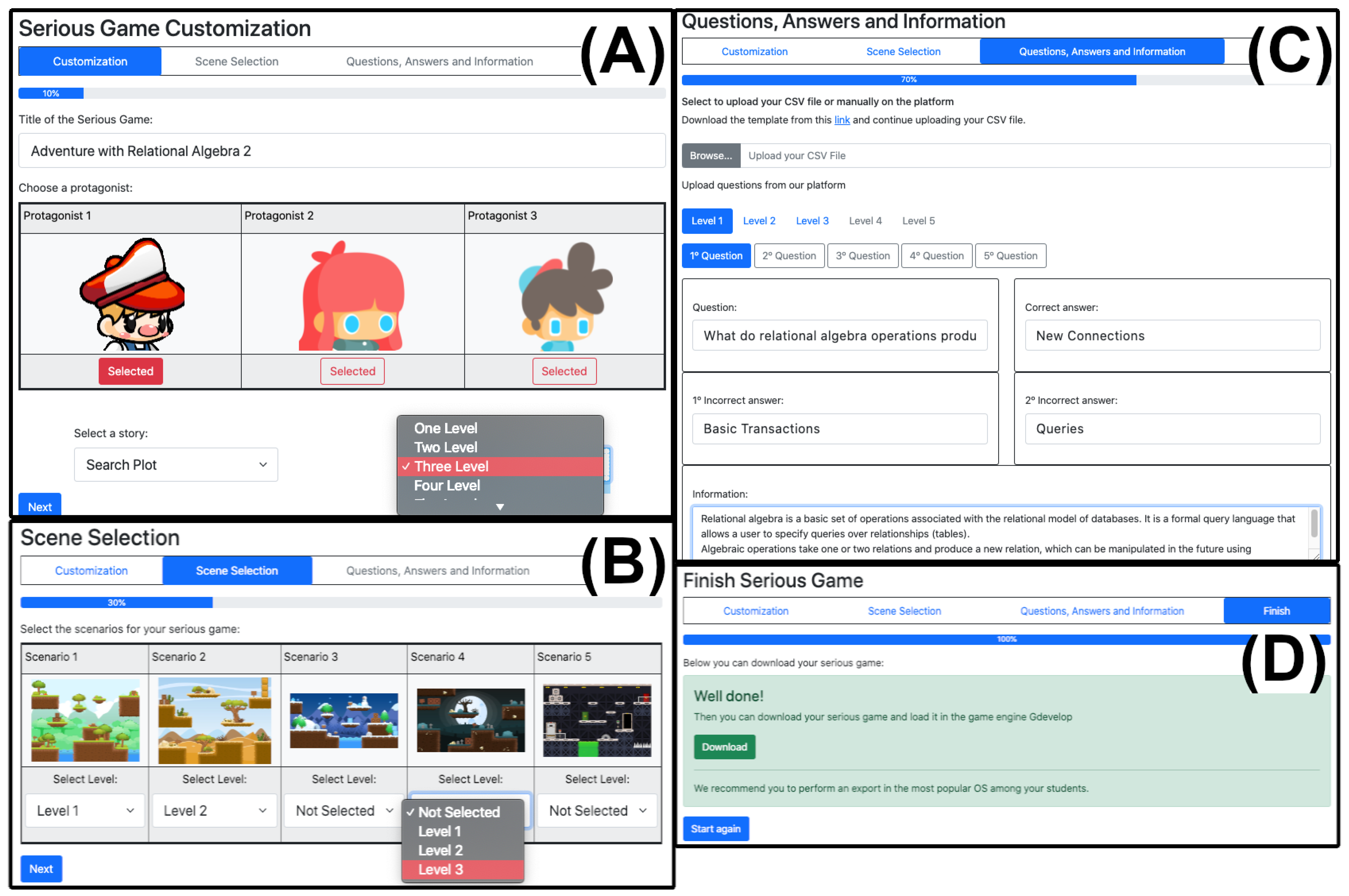

5. Evaluation and Discussion
5.1. Video Games Evaluations
5.2. ISO Evaluations
5.3. Qualitative Evaluation
5.3.1. Evaluation Design
5.3.2. Results
5.4. Quantitative Evaluation
5.4.1. Evaluation Design
5.4.2. Results
5.5. Discussion
6. Conclusions
Author Contributions
Funding
Institutional Review Board Statement
Informed Consent Statement
Data Availability Statement
Conflicts of Interest
References
- Hanes, L.; Stone, R. A model of heritage content to support the design and analysis of video games for history education. J. Comput. Educ. 2019, 6, 587–612. [Google Scholar] [CrossRef]
- Catalano, C.E.; Luccini, A.M.; Mortara, M. Guidelines for an effective design of serious games. Int. J. Serious Games 2014, 1. [Google Scholar] [CrossRef]
- de Lope, R.P.; López Arcos, J.R.; Medina-Medina, N.; Paderewski, P.; Gutiérrez-Vela, F.L. Design methodology for educational games based on graphical notations: Designing Urano. Entertain. Comput. 2017, 18, 1–14. [Google Scholar] [CrossRef]
- González García, C.; Núñez-Valdez, E.R.; Moreno-Ger, P.; González Crespo, R.; Pelayo G-Bustelo, B.C.; Cueva Lovelle, J.M. Agile development of multiplatform educational video games using a Domain-Specific Language. Univers. Access Inf. Soc. 2019, 18, 599–614. [Google Scholar] [CrossRef]
- Chamberlin, B.; Trespalacios, J.; Gallagher, R. The learning games design model: Immersion, collaboration, and outcomes-driven development. Int. J. Game-Based Learn. 2012, 2, 87–110. [Google Scholar] [CrossRef]
- Mostafa, M.; Faragallah, O.S. Development of Serious Games for Teaching Information Security Courses. IEEE Access 2019, 7, 169293–169305. [Google Scholar] [CrossRef]
- Zarraonandia, T.; Diaz, P.; Aedo, I. Using combinatorial creativity to support end-user design of digital games. Multimed. Tools Appl. 2017, 76, 9073–9098. [Google Scholar] [CrossRef]
- Aleem, S.; Capretz, L.F.; Ahmed, F. Critical Success Factors to Improve the Game Development Process from a Developer’s Perspective. J. Comput. Sci. Technol. 2016, 31, 925–950. [Google Scholar] [CrossRef]
- Ahmad, A.; Law, E.L.C. Educators as Gamemasters: Creating Serious Role Playing Game with “aRQS”. Proc. ACM Hum. Comput. Interact. 2021, 5, 230–259. [Google Scholar] [CrossRef]
- Marchiori, E.J.; del Blanco, Á.; Torrente, J.; Martinez-Ortiz, I.; Fernández-Manjón, B. A visual language for the creation of narrative educational games. J. Vis. Lang. Comput. 2011, 22, 443–452. [Google Scholar] [CrossRef]
- Marne, B.; Wisdom, J.; Huynh-Kim-Bang, B.; Labat, J.M. The Six Facets of Serious Game Design: A Methodology Enhanced by Our Design Pattern Library. In Proceedings of the European Conference on Technology Enhanced Learning, Saarbrücken, Germany, 18–21 September 2012; pp. 208–221. [Google Scholar] [CrossRef]
- Carvalho, M.B.; Bellotti, F.; Berta, R.; De Gloria, A.; Sedano, C.I.; Hauge, J.B.; Hu, J.; Rauterberg, M. An activity theory-based model for serious games analysis and conceptual design. Comput. Educ. 2015, 87, 166–181. [Google Scholar] [CrossRef]
- Zarraonandia, T.; Diaz, P.; Aedo, I.; Ruiz, M.R. Designing educational games through a conceptual model based on rules and scenarios. Multimed. Tools Appl. 2015, 74, 4535–4559. [Google Scholar] [CrossRef]
- Arnab, S.; Lim, T.; Carvalho, M.B.; Bellotti, F.; De Freitas, S.; Louchart, S.; Suttie, N.; Berta, R.; De Gloria, A. Murdoch Research Repository Mapping Learning and Game Mechanics for Serious Games Analysis. Br. J. Educ. Technol. 2015, 46, 391–411. [Google Scholar] [CrossRef]
- Cano, S.; Munoz Arteaga, J.; Collazos, C.A.; Gonzalez, C.S.; Zapata, S. Toward a methodology for serious games design for children with auditory impairments. IEEE Lat. Am. Trans. 2016, 14, 2511–2521. [Google Scholar] [CrossRef]
- Orji, R.; Mandryk, R.L.; Vassileva, J. Improving the efficacy of games for change using personalization models. ACM Trans. Comput. Hum. Interact. 2017, 24, 32–54. [Google Scholar] [CrossRef]
- Andreoli, R.; Corolla, A.; Faggiano, A.; Malandrino, D.; Pirozzi, D.; Ranaldi, M.; Santangelo, G.; Scarano, V. A framework to design, develop, and evaluate immersive and collaborative serious games in cultural heritage. J. Comput. Cult. Herit. 2017, 11, 4–26. [Google Scholar] [CrossRef]
- Heintz, S.; Law, E.L. Digital educational games: Methodologies for evaluating the impact of game type. ACM Trans. Comput. Hum. Interact. 2018, 25, 8–33. [Google Scholar] [CrossRef]
- Carrión-Toro, M.; Santorum, M.; Acosta-Vargas, P.; Aguilar, J.; Pérez, M. iPlus a user-centered methodology for serious games design. Appl. Sci. 2020, 10, 9007. [Google Scholar] [CrossRef]
- Pérez, F.; Lapeña, R.; Marcén, A.C.; Cetina, C. Topic modeling for feature location in software models: Studying both code generation and interpreted models. Inf. Softw. Technol. 2021, 140, 106676. [Google Scholar] [CrossRef]
- Blasco, D.; Font, J.; Zamorano, M.; Cetina, C. An evolutionary approach for generating software models: The case of Kromaia in Game Software Engineering. J. Syst. Softw. 2021, 171, 110804. [Google Scholar] [CrossRef]
- Oren, M.; Pedersen, S.; Butler-Purry, K.L. Teaching Digital Circuit Design with a 3-D Video Game: The Impact of Using In-Game Tools on Students’ Performance. IEEE Trans. Educ. 2021, 64, 24–31. [Google Scholar] [CrossRef]
- Göbel, S.; Salvatore, L.; Konrad, R. StoryTec: A digital storytelling platform for the authoring and experiencing of interactive and non-linear stories. In Proceedings of the 4th International Conference on Automated Solutions for Cross Media Content and Multi-Channel Distribution, Florence, Italy, 17–19 November 2008; pp. 103–110. [Google Scholar] [CrossRef]
- Mourato, F.; Dos Santos, M.P.; Birra, F. Integrated system for automatic platform game level creation with difficulty and content adaptation. Lect. Notes Comput. Sci. 2012, 7522, 409–412. [Google Scholar] [CrossRef]
- Mourato, F.J.D.S.V. Enhancing Automatic Level Generation for Platform Videogames. Ph.D. Thesis, Universidade NOVA de Lisboa, Lisboa, Portugal, 2015. [Google Scholar]
- McArthur, V.; Teather, R.J. Serious mods: A case for modding in serious games pedagogy. In Proceedings of the 2015 IEEE Games Entertainment Media Conference, Toronto, ON, Canada, 14–16 October 2015. [Google Scholar] [CrossRef]
- Perez-Colado, I.J.; Perez-Colado, V.M.; Martinez-Ortiz, I.; Freire-Moran, M.; Fernandez-Manjon, B. UAdventure: The eAdventure reboot: Combining the experience of commercial gaming tools and tailored educational tools. IEEE Glob. Eng. Educ. Conf. 2017, 1, 1755–1762. [Google Scholar] [CrossRef]
- Calderón, A.; Boubeta-Puig, J.; Ruiz, M. MEdit4CEP-Gam: A model-driven approach for user-friendly gamification design, monitoring and code generation in CEP-based systems. Inf. Softw. Technol. 2018, 95, 238–264. [Google Scholar] [CrossRef]
- Aramini, U.; Lanzi, P.; Loiacono, D. An Integrated Framework for AI Assisted Level Design in 2D Platformers. In Proceedings of the 2018 IEEE Games, Entertainment, Media Conference (GEM), Galway, Ireland, 15–17 August 2018. [Google Scholar]
- Bontchev, B.; Panayotova, R. Towards automatic generation of serious maze games for education. Serdica J. Comput. 2018, 11, 249–278. [Google Scholar] [CrossRef]
- Bontchev, B.; Vassileva, D.; Dankov, Y. The APOGEE software platform for construction of rich maze video games for education. In Proceedings of the 14th International Conference on Software Technologies (ICSOFT 2019), Prague, Czech Republic, 26–28 July 2019; Volume 1, pp. 491–498. [Google Scholar] [CrossRef]
- Grammatikopoulou, A.; Laraba, S.; Sahbenderoglu, O.; Dimitropoulos, K.; Douka, S.; Grammalidis, N. An adaptive framework for the creation of exergames for intangible cultural heritage (ICH) education. J. Comput. Educ. 2019, 6, 417–450. [Google Scholar] [CrossRef]
- Contreras-Espinosa, R.S.; Eguia-Gomez, J.L. A Prendizaje Informal Con Mods Para Videojuegos. Educ. Humanidades-Digit.-Aprendiz. Tecnol. Cibercultura 2019, 1, 301–319. [Google Scholar] [CrossRef]
- Hauck, E.; Aranha, C. Automatic Generation of Super Mario Levels via Graph Grammars. In Proceedings of the IEEE Conference on Computatonal Intelligence and Games, Osaka, Japan, 24–27 August 2020; pp. 297–304. [Google Scholar] [CrossRef]
- Marín-Vega, H.; Alor-Hernández, G.; Colombo-Mendoza, L.O.; Bustos-López, M.; Zataraín-Cabada, R. ZeusAR: A Process and an Architecture to Automate the Development of Augmented Reality Serious Games; Springer: New York, NY, USA, 2022; Volume 81, pp. 2901–2935. [Google Scholar] [CrossRef]
- Kitchenham, B.; Linkman, S.; Law, D. DESMET: A methodology for evaluating software engineering methods and tools. Comput. Control. Eng. J. 1997, 8, 120–126. [Google Scholar] [CrossRef]
- Quinn, M.M.; Symborski, C.; Barton, M.; Korris, J.; Falstad, T.; Granato, S. Methodology for playtesting serious games: A case study using a mixed method approach. In Proceedings of the IEEE Consumer Electronics Society’s International Games Innovations Conference, Kyoto, Japan, 22–26 July 2013; pp. 222–227. [Google Scholar] [CrossRef]
- Fu, F.L.; Su, R.C.; Yu, S.C. EGameFlow: A scale to measure learners’ enjoyment of e-learning games. Comput. Educ. 2009, 52, 101–112. [Google Scholar] [CrossRef]
- Phan, M.H.; Keebler, J.R.; Chaparro, B.S. The development and validation of the game user experience satisfaction scale (GUESS). Hum. Factors 2016, 58, 1217–1247. [Google Scholar] [CrossRef]
- Player Experience in Educational Video Games. Using Playability Heuristics to Evaluate Player Experience in Educational Video Games. J. Theor. Appl. Inf. Technol. 2020, 98, 3632–3642. [Google Scholar]
- Law, E.L.C.; Brühlmann, F.; Mekler, E.D. Systematic review and validation of the game experience questionnaire (geq)-implications for citation and reporting practice. In Proceedings of the 2018 Annual Symposium on Computer-Human Interaction in Play, Melbourne, VIC, Australia, 28–31 October 2018; pp. 257–270. [Google Scholar]
- Zubrow, D. Software quality requirements and evaluation, the ISO 25000 series. In Software Engineering; Software Engineering Institute: Pittsburgh, PA, USA, 2004. [Google Scholar]
- Roa, P.A.; Morales, C.; Gutiérrez, P. Norma iso/iec 25000. Tecnol. Investig. Acad. 2015, 3, 27–33. [Google Scholar]
- Symborski, C.; Barton, M.; Quinn, M.M.; Korris, J.H.; Kassam, K.S.; Morewedge, C.K. The design and development of serious games using iterative evaluation. Games Cult. 2017, 12, 252–268. [Google Scholar] [CrossRef]
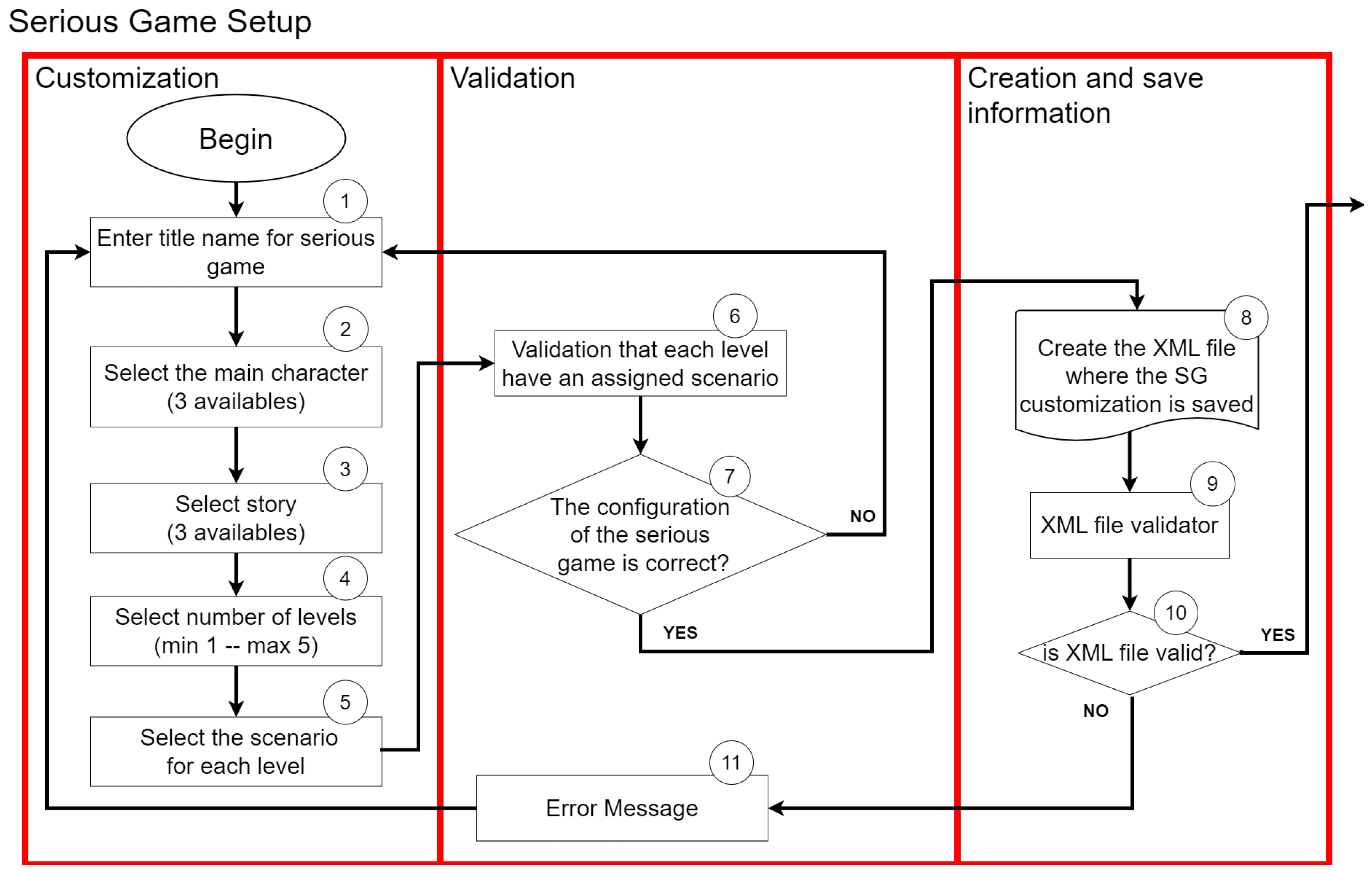

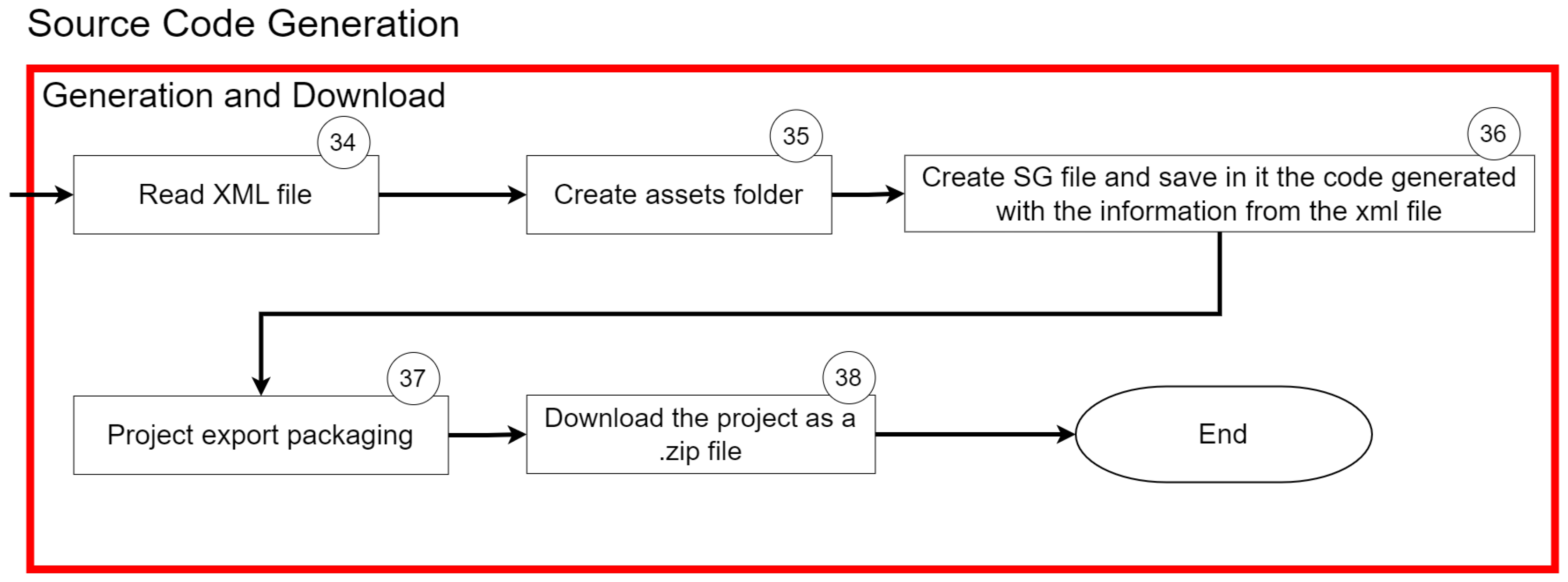

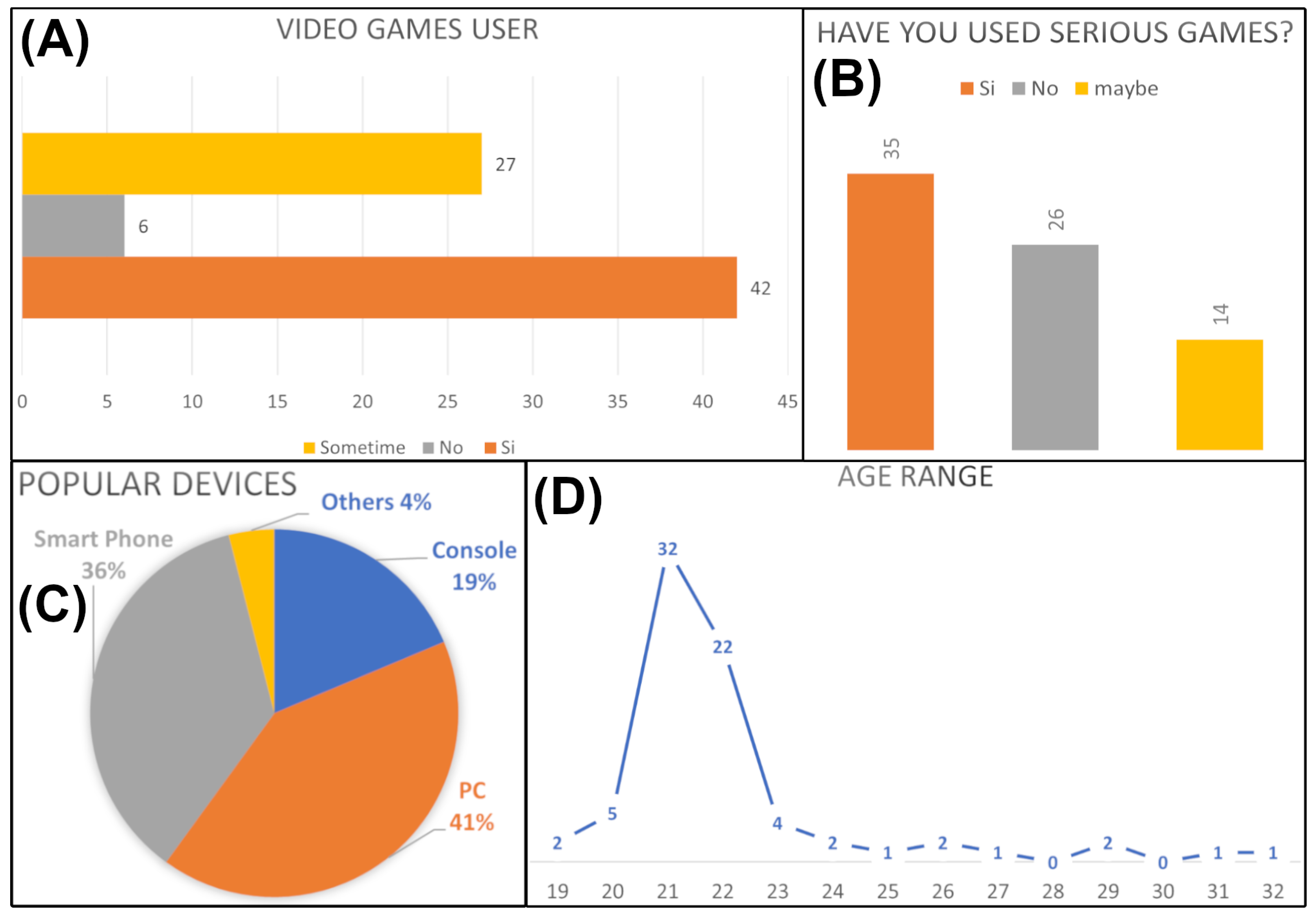
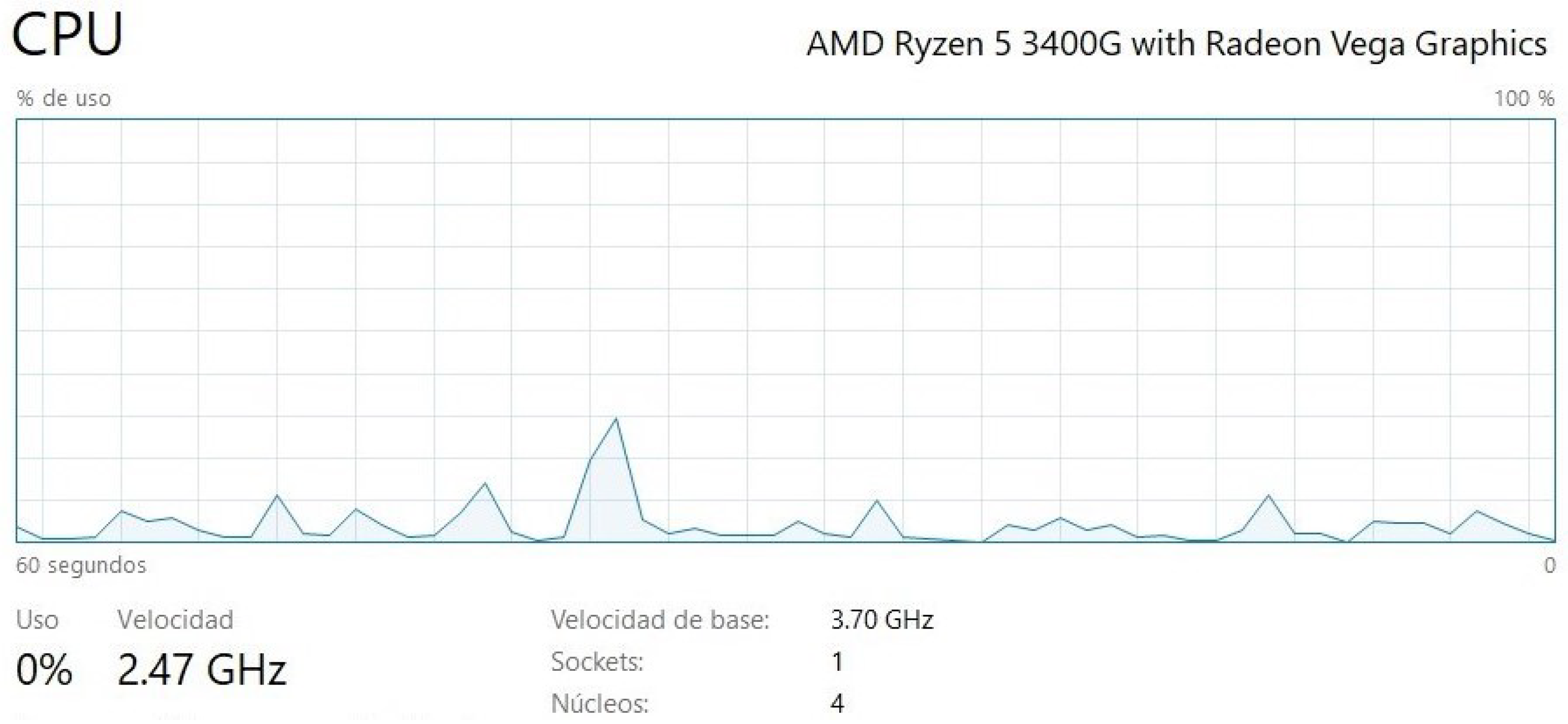
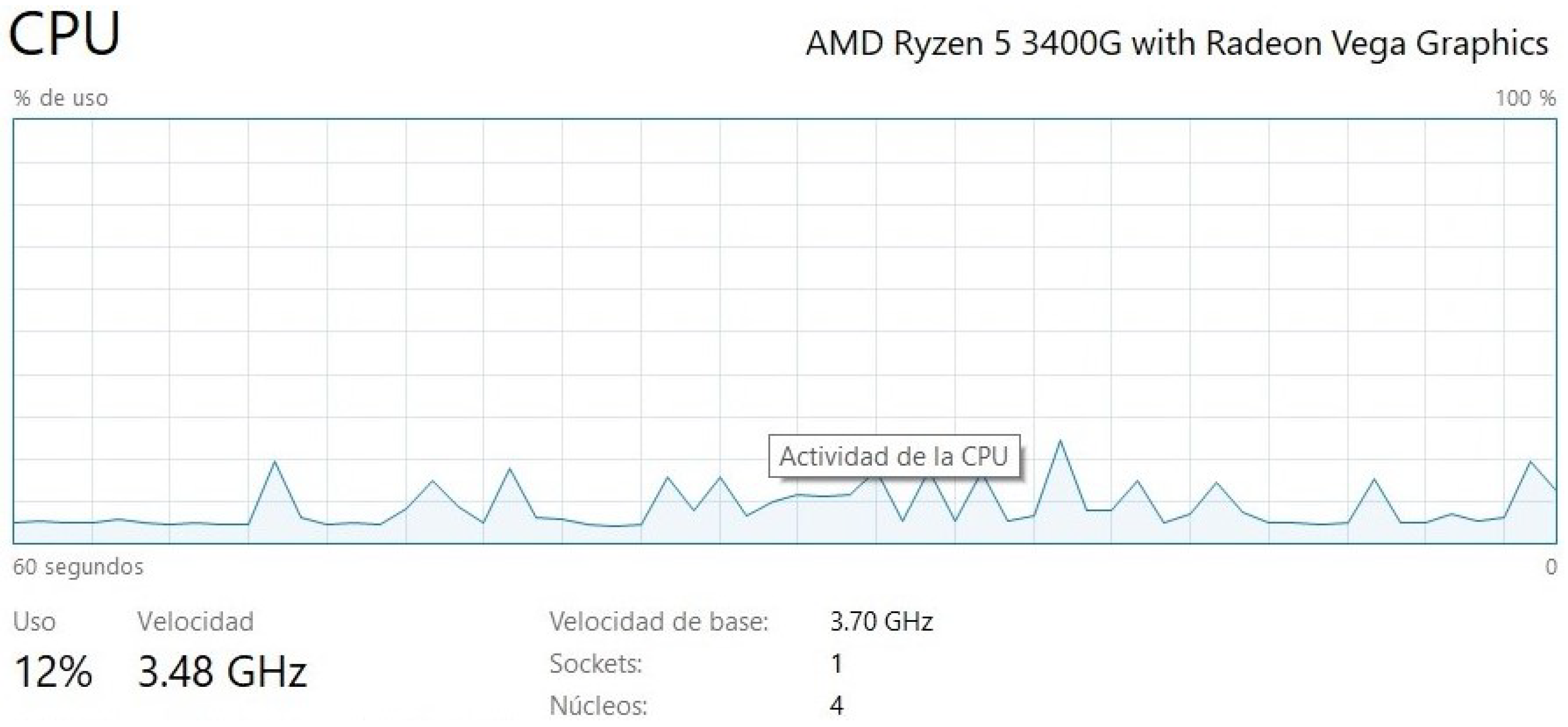
| Heuristic | Description | Totally Agree | Agree | Neither Agree nor Disagree | Disagree | Strongly Disagree |
|---|---|---|---|---|---|---|
| Gameplay | Does the game provide clear goals for the user? | 41% | 53% | 5% | 0% | 0% |
| Does the player see the progress in the game? | 20% | 52% | 16% | 12% | 0% | |
| Does the player feel in control of the game? | 33% | 49% | 12% | 4% | 1% | |
| Are the challenge, strategy, and pace balanced? | 31% | 51% | 9% | 9% | 0% | |
| Was the first-time experience encouraging? | 23% | 48% | 20% | 7% | 3% | |
| Mechanics | Are the game mechanics consistent throughout the game? | 32% | 60% | 7% | 1% | 0% |
| Are the controls easy to learn? | 60% | 35% | 4% | 1% | 0% | |
| Does the navigation system support the ease of gameplay? | 31% | 55% | 8% | 7% | 0% | |
| Is it easy to explore the playfield? | 33% | 56% | 9% | 1% | 0% | |
| Game Story | Is the game story meaningful? | 15% | 52% | 25% | 7% | 1% |
| Are there repetitive or boring tasks? | 8% | 32% | 43% | 16% | 1% | |
| Does the player have the opportunity to express him/herself? | 7% | 29% | 45% | 13% | 5% | |
| Does the player relate to the characters? | 4% | 48% | 25% | 17% | 5% | |
| Did the gameplay make sense with the story? | 12% | 52% | 27% | 7% | 3% | |
| Usability | Is the user interface consistent throughout the game? | 27% | 61% | 11% | 1% | 0% |
| Is the user interface similar to other games the user has experienced? | 39% | 49% | 9% | 3% | 0% | |
| Is the feedback to the user from the game adequate? | 41% | 55% | 4% | 0% | 0% | |
| Is all information that the user needs displayed clearly when the user needs it? | 37% | 49% | 8% | 5% | 0% | |
| Is the screen layout efficient? | 29% | 52% | 13% | 4% | 1% | |
| Is the screen layout visually appealing? | 25% | 53% | 16% | 5% | 0% | |
| Does the visual appearance support the playing of the game? | 28% | 61% | 7% | 3% | 1% | |
| Do the audio effects support the playing of the game? | 28% | 55% | 16% | 1% | 0% |
| Sub Characteristics | Metrics | Purpose | Method of Application | Formula | Desired Value |
|---|---|---|---|---|---|
| Resource utilization | CPU utilization | How much CPU time is used to perform a given task? | Take the operation time and the amount of CPU time used to perform a task | A = The amount of CPU time that is actually used to perform a task B = Operation time Where: B > 0 | 0 ≦ x ≦ 1 Closest to 0 is the best where the worst case is ≧15t |
| Memory Utilization | How much memory space is used to perform a given task? | Measure the total amount of memory space and the amount of memory space that is actually used to perform a task | A = Number of memory spaces that is actually used to perform a task B = Total amount of memory spaces Where: B > 0 | 0 ≦ x ≦ 15 The closest to 0 is the best |
Disclaimer/Publisher’s Note: The statements, opinions and data contained in all publications are solely those of the individual author(s) and contributor(s) and not of MDPI and/or the editor(s). MDPI and/or the editor(s) disclaim responsibility for any injury to people or property resulting from any ideas, methods, instructions or products referred to in the content. |
© 2023 by the authors. Licensee MDPI, Basel, Switzerland. This article is an open access article distributed under the terms and conditions of the Creative Commons Attribution (CC BY) license (https://creativecommons.org/licenses/by/4.0/).
Share and Cite
Silva-Vásquez, P.O.; Rosales-Morales, V.Y.; Benítez-Guerrero, E.; Alor-Hernández, G.; Mezura-Godoy, C.; Montané-Jiménez, L.G. Model for Semi-Automatic Serious Games Generation. Appl. Sci. 2023, 13, 5158. https://doi.org/10.3390/app13085158
Silva-Vásquez PO, Rosales-Morales VY, Benítez-Guerrero E, Alor-Hernández G, Mezura-Godoy C, Montané-Jiménez LG. Model for Semi-Automatic Serious Games Generation. Applied Sciences. 2023; 13(8):5158. https://doi.org/10.3390/app13085158
Chicago/Turabian StyleSilva-Vásquez, Pedro Omar, Viviana Yarel Rosales-Morales, Edgard Benítez-Guerrero, Giner Alor-Hernández, Carmen Mezura-Godoy, and Luis Gerardo Montané-Jiménez. 2023. "Model for Semi-Automatic Serious Games Generation" Applied Sciences 13, no. 8: 5158. https://doi.org/10.3390/app13085158
APA StyleSilva-Vásquez, P. O., Rosales-Morales, V. Y., Benítez-Guerrero, E., Alor-Hernández, G., Mezura-Godoy, C., & Montané-Jiménez, L. G. (2023). Model for Semi-Automatic Serious Games Generation. Applied Sciences, 13(8), 5158. https://doi.org/10.3390/app13085158








